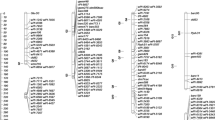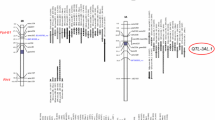Abstract
The grain yield of wheat is influenced by genotype, environment and genotype-by-environment interaction. A mapping population consisting of 182 doubled haploid progeny derived from a cross between the southern Australian varieties ‘Trident’ and ‘Molineux’, was used to characterise the interaction of previously mapped grain yield quantitative trait locus (QTL) with specific environmental covariables. Environments (17) used for grain yield assessment were characterised for latitude, rainfall, various temperature-based variables and stripe rust infection severity. The number of days in the growing season in which the maximum temperature exceeded 30°C was identified as the variable with the largest effect on site mean grain yield. However, the greatest QTL-by-environmental covariable interactions were observed with the severity of stripe rust infection. The rust resistance allele at the Lr37/Sr38/Yr17 locus had the greatest positive effect on grain yield when an environment experienced a combination of high-stripe rust infection and cool days. The grain yield QTL, QGyld.agt-4D, showed a very similar QTL-by-environment covariable interaction pattern to the Lr37/Sr38/Yr17 locus, suggesting a possible role in rust resistance or tolerance. Another putative grain yield per se QTL, QGyld.agt-1B, displayed interactions with the quantity of winter and spring rainfall, the number of days in which the maximum temperature exceeded 30°C, and the number of days with a minimum temperature below 10°C. However, no cross-over interaction effect was observed for this locus, and the ‘Molineux’ allele remained associated with higher grain yield in response to all environmental covariables. The results presented here confirm that QGyld.agt-1B may be a prime candidate for marker-assisted selection for improved grain yield and wide adaptation in wheat. The benefit of analysing the interaction of QTL and environmental covariables, such as employed here, is discussed.


Similar content being viewed by others
Abbreviations
- DH:
-
Doubled haploid
- GCI:
-
Genotype-by-environmental covariable interaction
- GEI:
-
Genotype-by-environment interaction
- QCI:
-
Quantitative trait locus-by-environmental covariable interaction
- QEI:
-
Quantitative trait locus-by-environment interaction
- QTL:
-
Quantitative trait locus
- T/M:
-
Trident/Molineux
References
Bariana HS, McIntosh RA (1993) Cytogenetic studies in wheat XV. Location of rust resistance genes in VPM1 and their genetic linkage with other disease resistance genes in chromosome 2A. Genome 36:476–482
Basford KE, Cooper M (1998) Genotype × environment interaction and some consideration of their implication for wheat breeding in Australia. Aust J Agric Res 49:153–174
Bernardo R (2002) Breeding for quantitative traits in plants. Stemma Press, Woodbury, USA
Borner A, Schumann E, Furste A, Coster H, Leithold B, Roder MS, Weber WE (2002) Mapping of quantitative trait loci determining agronomic important characters in hexaploid wheat (Triticum aestivum L.). Theor Appl Genet 105:921–936
Campbell BT, Baenziger PS, Eskridge KM, Budak H, Steck NA, Weiss A, Gill KS, Erayman M (2004) Using environmental covariates to explain genotype × environment and QTL × environment interaction for agronomic traits on chromosome 3A of wheat. Crop Sci 44:620–627
Campbell BT, Baenziger PS, Gill KS, Eskridge KM, Budak H, Erayman M, Yen Y (2003) Identification of QTLs and environmental interaction associated with agronomic traits on chromosome 3A of wheat. Crop Sci 43:1493–1505
Crossa J, Vargas M, van Eeuwijk FA, Jiang C, Edmeades GO, Hoisington D (1999) Interpreting gentype × environment interaction in tropical maize using linked molecular markers and environmental covariables. Theor Appl Genet 99:611–625
Eberhart SA, Russell WA (1966) Stability parameters for comparing varieties. Crop Sci 6:36–40
Ellis MH, Speilmeyer W, Gale KR, Rebetzke GJ, Richards RA (2002) “Perfect” markers for the Rht-B1b and Rht-D1b dwarfing genes in wheat. Theor Appl Genet 105:1038–1042
Finlay KW, Wilkinson GN (1963) The analysis of adaptation in a plant-breeding programme. Aust J Agric Res 14:742–754
Fischer RA, Maurer R (1978) Drought resistance in spring wheat cultivars. I grain yield responses. Aust J Agric Res 29:897–912
Gilmour AF, Cullis BR, Verbyla A (1997) Accounting for natural and extraneous variation in the analysis of field experiments. J Agric Biol Environ Stat 2:269–293
Groos C, Robert N, Bervas E, Charmet G (2003) Genetic analysis of grain protein-content, grain yield and thousand-kernel weight in bread wheat. Theor Appl Genet 106:1032–1040
Haley CS, Knott SA (1992) A simple regression method for mapping quantitative trait loci in line crosses using flanking markers. Heredity 69:315–324
Huang XQ, Kempf H, Ganal MW, Roder MS (2004) Advanced backcross QTL analysis in progenies derived from a cross between a German elite winter wheat variety and a synthetic wheat (Triticum aestivum L.). Theor Appl Genet 109:933–943
Kuchel H, Hollamby GJ, Langridge P, Williams KJ, Jefferies SP (2006a) Identification of genetic loci associated with ear-emergence in bread wheat. Theor Appl Genet 113:1103–1112
Kuchel H, Williams KJ, Langridge P, Eagles HA, Jefferies SP (2006b) Genetic dissection of grain yield in bread wheat. I. QTL analysis. Theor Appl Genet (this issue)
Lander ES, Botstein D (1989) Mapping mendelian factors underlying quantitative traits using RFLP linkage maps. Genetics 121:185–199
Malosetti M, Voltas J, Romagosa I, Ullrich SE, van Eeuwijk FA (2004) Mixed models including environmental covariables for studying QTL by environment interaction. Euphytica 137:139–145
Marza F, Bai G-H, Carver BF, Zhou W-C (2006) Quantitative trait loci for yield and related traits in the wheat population Nin7840 X Clark. Theor Appl Genet 112:688–698
McCartney CA, Somers DJ, Humphreys DG, Lukow O, Ames N, Noll J, Cloutier S, McCallum BD (2005) Mapping quantitative trait loci controlling agronomic traits in the spring wheat cross RL4452 × ’AC Domain’. Genome 48:870–883
Panozzo JF, Eagles HA (1998) Cultivar and environmental effects on quality characters in wheat. I. Starch. Aust J Agric Res 49:757–766
Payne RW, Baird DB, Cherry M, Gilmour AR, Harding SA, Kane AK, Lane PW, Murray DA, Soutar DM, Thompson R, Todd AD, Tunnicliffe Wilson G, Webster R, Welham SJ (2002) GenStat rlease 6.1 reference manual. VSN International, Oxford, UK
Piepho HP (2000) A mixed-model approach to mapping quantitative trait loci in barley on the basis of multiple environment data. Genetics 156:2043–2050
Ranjbar GA (1997) Production and utilisation of doubled haploid lines in wheat breeding programmes. Plant science. University of Adelaide, Adelaide
Sari-Gorla M, Calinski TZK, Krajewski P (1997) Detection of QTLxenvironment interaction in maize by least squares interval mapping method. Heredity 78:146–157
Seah S, Bariana H, Jahier J, Sivasithamparam K, Lagudah ES (2001) The introgressed segment carrying rust resistance genes Yr17, Lr37 and Sr38 in wheat can be assayed by a cloned disease resistance gene-like sequence. Theor Appl Genet 102:600–605
van Eeuwijk FA, Malosetti M, Yin X, Struik PC, Stam P (2005) Statistical models for genotype by environment data: from conventional ANOVA models to eco-physiological QTL models. Aust J Agric Res 56:883–894
Verbyla AP, Eckermann P, Thompson R, Cullis BR (2003) The analysis of quantitative trait loci in multi-environment trials using multiplicative mixed models. Aust J Agric Res 54:1395–1408
Whittaker JC, Thompson R, Visscher PM (1996) On the mapping of QTL by regression on marker-type. Heredity 77:23–32
Williams KJ, Willsmore KJ, Olson S, Matic M, Kuchel H (2006) Mapping of a novel QTL for resistance to cereal cyst nematode in wheat. Theor Appl Genet 112:1480–1486
Author information
Authors and Affiliations
Corresponding author
Additional information
Communicated by C.-C. Schön.
Rights and permissions
About this article
Cite this article
Kuchel, H., Williams, K., Langridge, P. et al. Genetic dissection of grain yield in bread wheat. II. QTL-by-environment interaction. Theor Appl Genet 115, 1015–1027 (2007). https://doi.org/10.1007/s00122-007-0628-8
Received:
Accepted:
Published:
Issue Date:
DOI: https://doi.org/10.1007/s00122-007-0628-8




